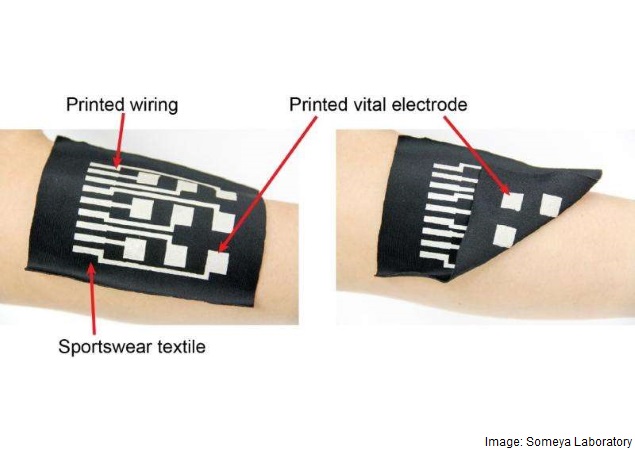- Home
- Wearables
- Wearables News
- New Ink to Make Electronic Apparel a Reality
New Ink to Make Electronic Apparel a Reality

This functional ink will enable electronic apparel such as sportswear and underwear incorporating sensing devices for measuring a range of biological indicators such as heart rate and muscle contraction.
Using this ink, the researchers created a wrist-band muscle activity sensor by printing an elastic conductor on a sportswear material and combining it with an organic transistor amplifier circuit.
This sensor can measure muscle activity by detecting muscle electrical potentials over an area of 4x4 square cms with nine electrodes placed two centimetres apart in a 3x3 grid.
"Our team aims to develop comfortable wearable devices. This ink was developed as part of this endeavour," said lead researcher professor Takao Someya.
"The biggest challenge was obtaining high conductivity and stretchability with a simple one-step printing process."
Current printed electronics, such as transistors, light emitting diodes and solar panels can be printed on plastic or paper substrates but these substrates tend to be rigid or hard.
However, it has proved difficult to make an ink that is both highly conductive and elastic without a complicated multi-step printing process.
The new ink is comprised of silver flakes, organic solvent, fluorine rubber and fluorine surfactant and exhibits high conductivity even when it is stretched to more than three times its original length.
"We were able to achieve this by use of a surfactant that allowed the silver flakes to self-assemble at the surface of the printed pattern, ensuring high conductivity," Someya said.
For the latest tech news and reviews, follow Gadgets 360 on X, Facebook, WhatsApp, Threads and Google News. For the latest videos on gadgets and tech, subscribe to our YouTube channel. If you want to know everything about top influencers, follow our in-house Who'sThat360 on Instagram and YouTube.
Related Stories
- Samsung Galaxy Unpacked 2025
- ChatGPT
- Redmi Note 14 Pro+
- iPhone 16
- Apple Vision Pro
- Oneplus 12
- OnePlus Nord CE 3 Lite 5G
- iPhone 13
- Xiaomi 14 Pro
- Oppo Find N3
- Tecno Spark Go (2023)
- Realme V30
- Best Phones Under 25000
- Samsung Galaxy S24 Series
- Cryptocurrency
- iQoo 12
- Samsung Galaxy S24 Ultra
- Giottus
- Samsung Galaxy Z Flip 5
- Apple 'Scary Fast'
- Housefull 5
- GoPro Hero 12 Black Review
- Invincible Season 2
- JioGlass
- HD Ready TV
- Laptop Under 50000
- Smartwatch Under 10000
- Latest Mobile Phones
- Compare Phones
- Moto G15 Power
- Moto G15
- Realme 14x 5G
- Poco M7 Pro 5G
- Poco C75 5G
- Vivo Y300 (China)
- HMD Arc
- Lava Blaze Duo 5G
- Asus Zenbook S 14
- MacBook Pro 16-inch (M4 Max, 2024)
- Honor Pad V9
- Tecno Megapad 11
- Redmi Watch 5
- Huawei Watch Ultimate Design
- Sony 65 Inches Ultra HD (4K) LED Smart TV (KD-65X74L)
- TCL 55 Inches Ultra HD (4K) LED Smart TV (55C61B)
- Sony PlayStation 5 Pro
- Sony PlayStation 5 Slim Digital Edition
- Blue Star 1.5 Ton 3 Star Inverter Split AC (IC318DNUHC)
- Blue Star 1.5 Ton 3 Star Inverter Split AC (IA318VKU)

















